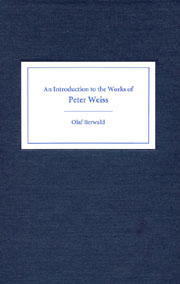Book contents
- Frontmatter
- Contents
- Acknowledgments
- Introduction
- 1 Subversive Slapstick: The Early Plays Der Turm, Die Versicherung, Nacht mit Gästen, and Mockinpott
- 2 The Choreography of Documents: Die Ermittlung, Gesang vom Lusitanischen Popanz, and Viet Nam Diskurs
- 3 Staging Writers as Outcasts: Marat/Sade, Trotzki im Exil, Hölderlin, Der Prozess, and Der neue Prozess
- 4 Scenarios of Stagnation: Early Prose
- 5 Autobiography and Fiction: Abschied von den Eltern, Fluchtpunkt, and Rekonvaleszenz
- 6 Poetics and Politics: Essays, Open Letters, and Fragments
- 7 Perception as Resistance: Die Ästhetik des Widerstands
- Works Consulted
- Index
Introduction
Published online by Cambridge University Press: 05 February 2013
- Frontmatter
- Contents
- Acknowledgments
- Introduction
- 1 Subversive Slapstick: The Early Plays Der Turm, Die Versicherung, Nacht mit Gästen, and Mockinpott
- 2 The Choreography of Documents: Die Ermittlung, Gesang vom Lusitanischen Popanz, and Viet Nam Diskurs
- 3 Staging Writers as Outcasts: Marat/Sade, Trotzki im Exil, Hölderlin, Der Prozess, and Der neue Prozess
- 4 Scenarios of Stagnation: Early Prose
- 5 Autobiography and Fiction: Abschied von den Eltern, Fluchtpunkt, and Rekonvaleszenz
- 6 Poetics and Politics: Essays, Open Letters, and Fragments
- 7 Perception as Resistance: Die Ästhetik des Widerstands
- Works Consulted
- Index
Summary
In searching for an art of writing capable of confronting the violent beginnings of the new millennium, it is indispensable to study the literary oeuvre of Peter Weiss (1916–1982), whose plays and narrative works have helped to shape European modernism in the second half of the twentieth century. Weiss's literary works explore how a writer can assume social responsibility while working toward multifaceted modes of artistic expression. Combining aesthetic openness with an uncompromising ethical drive, Weiss's literary works, for example his plays Marat/Sade (1963) and Die Ermittlung (1965, The Investigation), and especially his novel Die Ästhetik des Widerstands (1975–81, The Aesthetics of Resistance), provide vital reference points for any discussion of culture and politics in our times.
Peter Ulrich Weiss was born during the First World War, on November 8, 1916, in Nowawes, near Potsdam. He was the son of Eugen Jenö Weiss (1885–1959), a Slovak Jewish textile entrepreneur, and the Swiss actress Frieda Franziska Weiss, née Hummel (1885–1958). In 1917, the Weiss family resided in Przemyśl (Galicia) but returned to the Potsdam area the following year. In 1919 his family moved to Bremen, and lived there until moving on to Berlin in 1929, where they remained until 1934.
In August 1934, Weiss's sister Margit Beatrice Weiss died in a car accident, an event whose impact permeates much of Weiss's visual art and literary works. He immigrated with his family to England in 1935 to escape Nazi persecution.
- Type
- Chapter
- Information
- An Introduction to the Works of Peter Weiss , pp. 1 - 10Publisher: Boydell & BrewerPrint publication year: 2003

